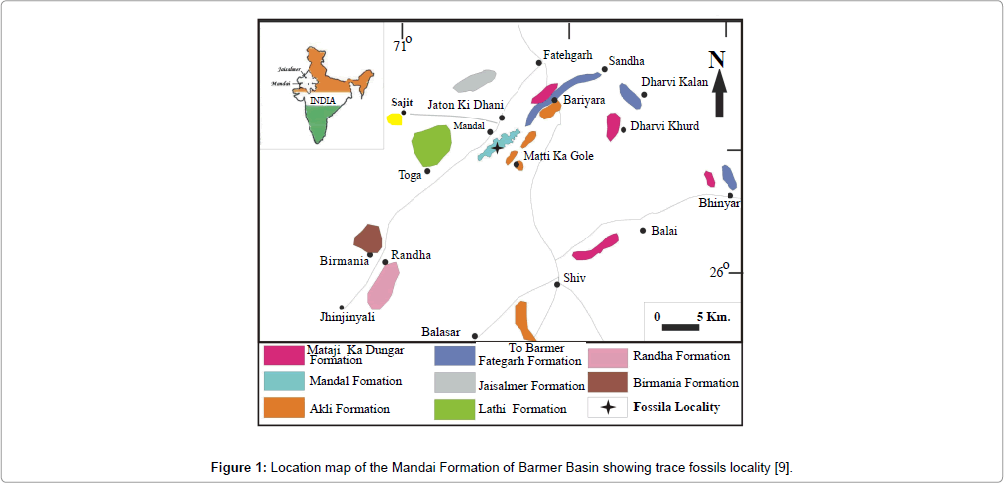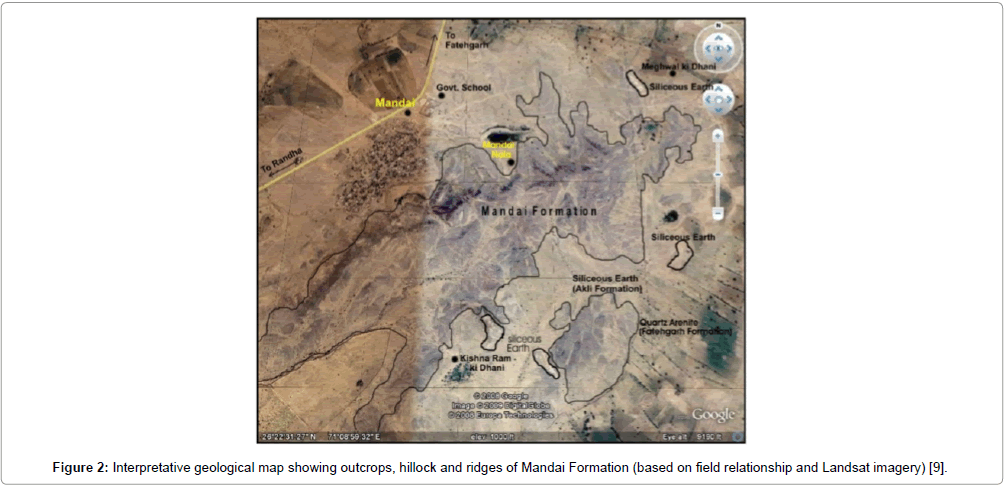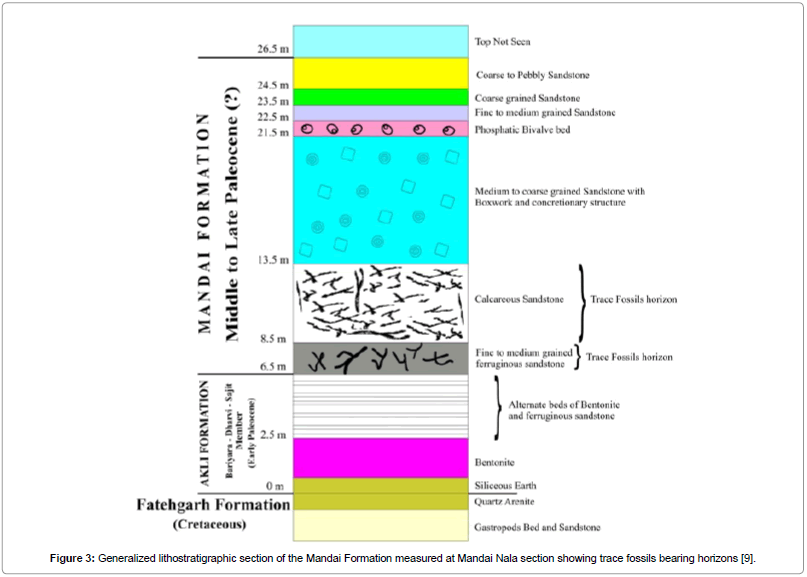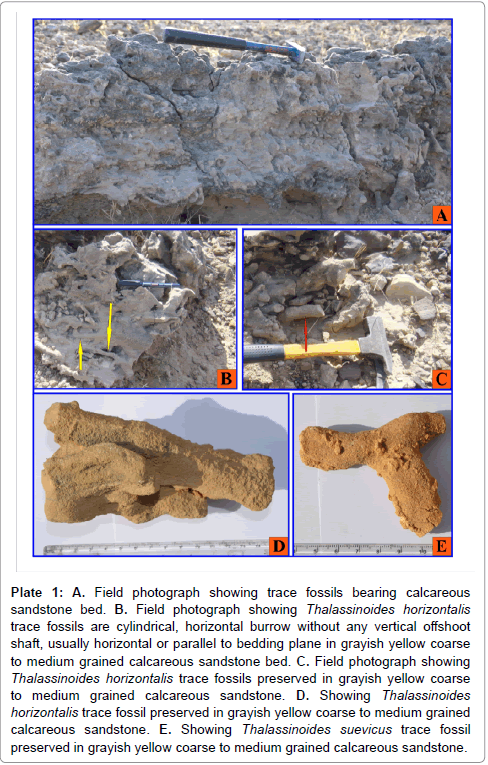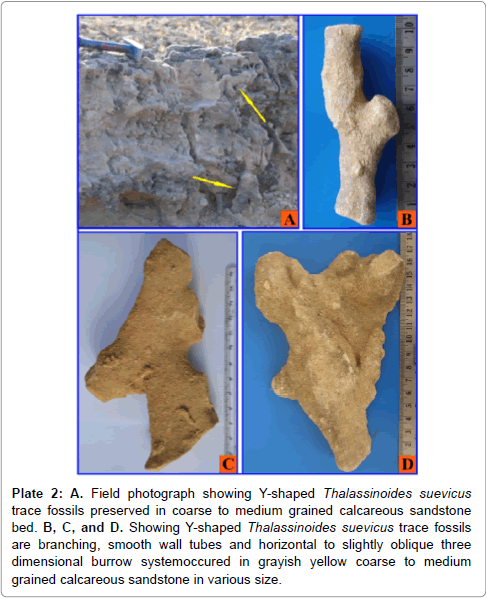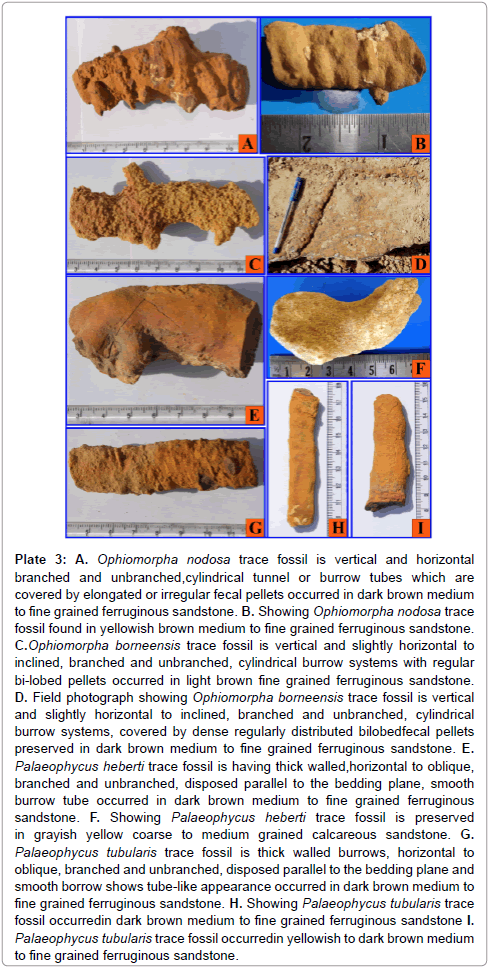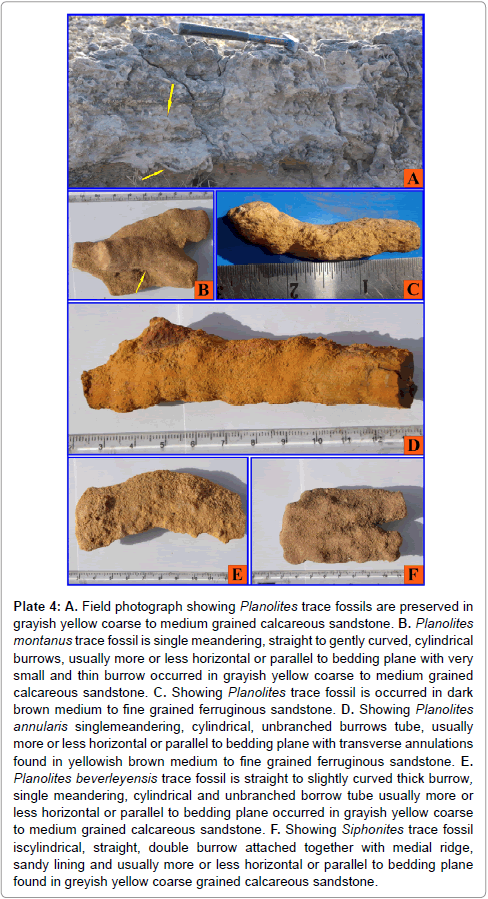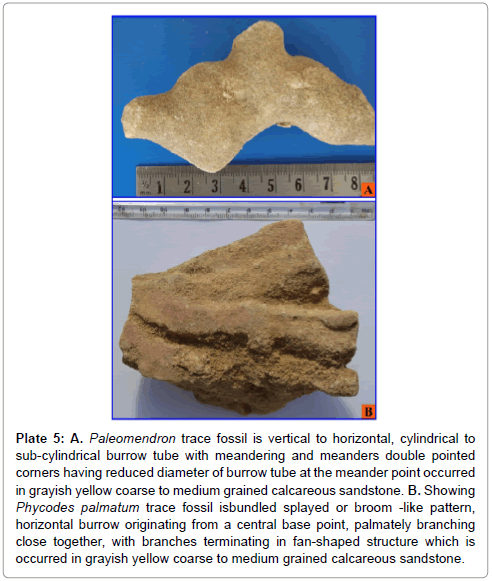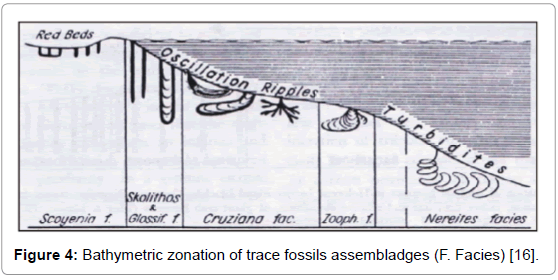Research Article Open Access
Shallow Marine Trace Fossils from Mandai Formation of the Barmer Basin, District -Jaisalmer, Western Rajasthan, India
Parihar VS1*, Nama SL2 and Mathur SC1
1Department of Geology, Jai Narain Vyas University, Jodhpur, Rajasthan, India.
2Department of Zoology, Jai Narain Vyas University, Jodhpur, Rajasthan, India.
- *Corresponding Author:
- Parihar VS
Department of Geology
Jai Narain Vyas University
Jodhpur -342005, Rajasthan, India
Tel: +90374 254 2665
Fax: +91- 9929217873
E-mail: geoparihar@gmail.com
Received Date: April 29, 2015; Accepted Date: May 31, 2016; Published Date: June 08, 2016
Citation: Parihar VS, Nama SL, Mathur SC (2016) Shallow Marine Trace Fossils from Mandai Formation of the Barmer Basin, District-Jaisalmer, Western Rajasthan, India. J Ecosys Ecograph 6:189. doi:10.4172/2157-7625.1000189
Copyright: © 2016 Parihar VS, et al. This is an open-access article distributed under the terms of the Creative Commons Attribution License, which permits unrestricted use, distribution, and reproduction in any medium, provided the original author and source are credited.
Visit for more related articles at Journal of Ecosystem & Ecography
Abstract
Thirteen well-preserved trace fossil species namely Thalassinoides horizontalis, Thalassinoides suevicus, Ophiomorpha nodosa, Ophiomorpha borneensis, Palaeophycus heberti, Palaeophycus tubularis, Planolites, Planolites montanus, Planolites beverleyensis, Planolites annularis, Siphonites, Paleomendron, and Phycodes palmatum have been reported from Mandai Formation of the Barmer Basin at Mandai area, western Rajasthan, India. The present study area is located about 15 km southwest of Fatehgarh town on Fatehgarh –Jhinjinyali tar Road. The Mandai Formation is 27 m thick lithostratigraphic unit deposited in the north-western part of the Barmer Basin and overlies on Early Palaeocene Bariyara -Dharvi -Sajit Member of the Akli Formation and overlain by Giral -Thumbli Member of Akli Formation of Early Eocene. The Mandai Formation has mixed siliciclastic, minor carbonate and phosphorite facies and its starts with bioturbated medium to fine grained ferruginous sandstone at the base. These trace fossils are preserved of full relief in yellowish to dark brown medium to fine grained ferruginous sandstone and greyish yellow coarse and coarse to medium grained calcareous sandstone. The entire ichnogenera shows shallow marine depositional environment of Mandai Formation of Barmer Basin. No age can be assigned on the basis of these trace fossil as they have long range (Cambrian to Recent).
Keywords
Shallow marine; Trace fossils; Mandai formation; Barmer basin; Jaisalmer and Western Rajasthan
Introduction
Barmer Basin is mainly Tertiary basin, opened as narrow, roughly N-S trending linear graben and it has a maximum length 100 km; while the width is about 50 km [1]. Biswas et al. [2] opined that Barmer Basin considered as northern extension of Cambay Basin connected through the Sanchore Basin. The Barmer Basin is floored by Malani igneous suite, Lathi sandstone and Jaisalmer Formation [3]. The sediments of the Barmer Basin are classified into eight formations viz; Sarnu Formation, Fatehgarh Formatiom, Mandai Formation, Barmer Hill Formation, Akli Formation, Mataji ka Dungar Formation, Kapurdi Formation and Uttarlai Formation. The Sarnu Formation is represented by red siltstone and sandstone with plant fossils, the Fatehgarh Formation comprises siltstone, ferruginous sandstone, phosphatic sandstone having significant microvertebrates- magnetic spherule bearing bone bed and gastropod bed [4,5], the Mandai Formation is represented by bioturbated ferruginous sandstone and calcareous sandstone, medium to coarse grained sandstone, phosphatic bivalves bed, fine to medium grained sandstone, coarse grained sandstone and pebbly sandstone [6], the Barmer Hill Formation comprises sandy sandstone with chert and poorly preserved plant fossils and well -preserved Asthenopodichium wood bearing trace fossils [7], the Akli Formation is represented by bentonite, clay, lignite and ferruginous sandstone with gastropods, microvertebrates and plant fossils [8], the Mataji ka Dungar Formation is dominantly composed of coarse grained sandstone, ferruginous sandstone and clay and bentonitic clay at the base [6,9], the Kapurdi Formation is represented by fuller’s-Earth, gypseous clay, bioclastic limestone and marl with plants fossils, crabs, shrimps, turtles, fishes and gastropods [10] and the Uttarlai Formation comprises salt, gypsum, gypseous clay and sands [1]. Many trace fossils have been already reported from the rocks of the Barmer Basin by various researchers such as Borkar et al. [11], recorded Thalassinoides, Planolites and Planolites Montanus from Fatehgarh Formation; nearshore – shallow marine trace fossils from Fatehgarh Formation reported by Parihar et al. [7,9] and trace fossils from Mandai Formation reported by Parihar et al. [12]. The present investigation here deals with detailed study of shallow marine trace fossils from Mandai Formation of Barmer Basin at Mandai area viz; Ophiomorpha nodosa, Ophiomorpha borneensis, Palaeophycus heberti, Palaeophycus tubularis, Planolites annularis trace fossils found in yellowish to dark brown medium to fine grained ferruginous sandstone and Thalassinoides horizontalis, Thalassinoides suevicus, Planolites, Planolites montanus, Planolites beverleyensis, Siphonites, Paleomeandron and Phycodes palmatum trace fossils are occurred in greyish yellow coarse and coarse to medium grained calcareous sandstone in the lower phosphatic – carbonate dominated sequence of Mandai Formation. The objectives of present paper (i) To first reports of 13 trace fossils from Mandai Formation of the Barmer Basin. (ii) To the systematic ichnology of trace fossils and environment of deposition of trace fossils bearing facies of the Mandai Formation of Barmer Basin, Western Rajasthan, India.
Geology of the Study Area
The Mandai Formation is located about 15 km south -west of Fatehgarh on Fatehgarh-Jhinjinyali tar Road (Figure 1). The Mandai Formation is 27 m thick lithostratigraphic unit deposited in the north -western part of the Barmer Basin. The various lithounits of the Mandai Formation forms low to high ridges and hillocks in and around Mandai Village. The Mandai ridge running from south of the Jaton ki Dhani and up to Mandai in the south and the overall strike length of ridges is about 10 kms (Figure 2). The Mandai Formation overlies on Early Palaeocene Bariyara-Dharvi-Sajit Member of the Akli Formation and overlain by Giral-Thumbli Member of Akli Formation of Early Eocene age. The lithology of the Mandai Formation of Barmer Baisn are classify into two classes indicating two different sedimentary environments, they are mainly, the lower phosphatic-carbonate dominated lithofacies association comprised of ferruginous sandstone and calcareous sandstone have extension bioturbations, medium to coarse grained sandstone with boxworks and concretionary structures phosphatic bivalves bed and upper coarsening upward lithofacies association of siliciclastic sequences consists of fine to medium grained sandstone, coarse grained sandstone and pebbly sandstone mark the top of the Mandai Formation (Table 1) [6]. The Ophiomorpha nodosa, Ophiomorpha borneensis, Palaeophycus heberti, Palaeophycus tubularis, Planolites annularis trace fossils found in yellowish to dark brown medium to fine grained ferruginous sandstone and Thalassinoides horizontalis, Thalassinoides suevicus, Planolites montanus, Planolites beverleyensis, Siphonites, Paleomeandron and Phycodes palmatum trace fossils occurred in greyish yellow coarse and coarse to medium grained calcareous sandstone in the lower phosphatic – carbonate dominated sequence of Mandai Formation at Mandai area (Figure 3).
| Mandai Formation (Middle to Late Paleocene (?)) | Siliciclastic dominated lithofaciesassociztion | Pebbly sandstone, Coarse grained sandstone. Fine to medium grained sandstone. |
|---|---|---|
| Carbonate ��? phosphate dominated lithofacies association | Phosphatic bivalve bed, Sandstone with boxwork structures,Calcareous and Ferruginous sandstone bearing trace fossils. | |
| Akli Formation (Early Paleocene) | Bariyara ��? Sajit��?Dharvimember | Repetitive sequence ofBentonite, clay and Fine to medium grained sandstone,Siliceous Earth. |
| Fatehgarh Formation (Cretaceous) | Upper siliciclasticfacies | Quartz arenite, gastropod bed and sandstone. |
Table 1: Generalized geological succession of the Mandai Formation [9].
Palaeontology
Trace fossils:The present paper here reports thirteen trace fossils from yellowish to dark brown medium to fine grained ferruginous sandstone and greyish yellow coarse, coarse to medium grained calcareous sandstone of Mandai Formation of Barmer Basin. They are identified as Thalassinoides horizontalis, Thalassinoides suevicus, Ophiomorpha nodosa, Ophiomorpha borneensis, Palaeophycus heberti, Palaeophycus tubularis, Planolites, Planolites montanus, Planolites beverleyensis, Planolites annularis, Siphonites, Paleomendron, and Phycodes palmatum. All these trace fossils are well-preserved and abundant nature in Mandai Formation of Barmer Basin in Mandai area.
Methodology
The sedimentological, ichnological variation and responses of Trace fossils to sediments have been studied from the present Mandai Formation section in the field and accordingly lithostratigraphic section has been prepared. All the measurements of the trace fossils have been done in the field. All ichnological interpretations are based on field observations and collected specimens kept for repository in our palaeontology lab. The present study of ichnology follows the Treatise on invertebrate Palaeontology [13]. The morphological classification of Simpson [14], ethological classification of Seilacher [15] and facies classification of Seilacher [15,16] are adopted.
Systematic ichnology
Ichnogenus: Thalassinoides
Ichnospecies: Thalassonoids horizontalis isp [17], (Plates 1B-1D)
Material: Specimen Nos. DG/JNVU/MF/TF/103,104,105 and Field Photos.
Plate 1: A. Field photograph showing trace fossils bearing calcareous sandstone bed. B. Field photograph showing Thalassinoideshorizontalistrace fossils are cylindrical, horizontal burrow without any vertical offshoot shaft, usually horizontal or parallel to bedding plane in grayish yellow coarse to medium grained calcareous sandstone bed. C. Field photograph showing Thalassinoideshorizontalistrace fossils preserved in grayish yellow coarse to medium grained calcareous sandstone. D. Showing Thalassinoideshorizontalistrace fossil preserved in grayish yellow coarse to medium grained calcareous sandstone. E. Showing Thalassinoidessuevicustrace fossil preserved in grayish yellow coarse to medium grained calcareous sandstone.
Description: Cylindrical, horizontal burrow without any vertical offshoot shaft, disposed parallel to the bedding plane, more or less regularly branched, unlined burrow system with smooth wall tube, burrow tubes length varying from 15-16 cm and diameter of burrow tube from 1.5-3.0 cm. Normally burrow tubes are filled with calcareous sediments.
Remark: They are mainly produced by crustaceans [18-20] and considered as a feeding burrow system created in water saturated cohesive substrate under oxygenated and energetic environments. The crustaceans producing Thalassinoides may survive transport in turbidity currents and produce burrow anoxic conditions for a limited time. The present burrows show much similarity with that of Thalassonoids horizontalis, [17] and also correlated the Thalassonoids horizontalis from the Palaeogene sediments of the Pondicherry area [21], from Kaladongar Formation, Patcham Island, Kachchh [22] and from Mesozoic sediments of Jaisalmer Basin [23].
Occurrences: Greyish yellow coarse to medium grained calcareous sandstone, Mandai Formation, Barmer Basin, Mandai Area, Jaisalmer.
Ichnospecies; Thalassinoides suevicus isp., (Plates 1E, 2A-2D)
Material: Specimen Nos. DG/JNVU/MF/TF/106,107,108,109 and Field Photo.
Plate 2: A. Field photograph showing Y-shaped Thalassinoidessuevicustrace fossils preserved in coarse to medium grained calcareous sandstone bed. B, C,and D. Showing Y-shaped Thalassinoidessuevicustrace fossils are branching, smooth wall tubes and horizontal to slightly oblique three dimensional burrow systemoccured in grayish yellow coarse to medium grained calcareous sandstone in various size.
Description: Thalassinoides suevicus trace fossils are Y-shaped branching, full relief, smooth wall tubes, horizontal to slightly oblique three dimensional burrow system (displaying a network of triple junction), burrow tubes length varying from 8-22 cm and diameter of burrow tube from 1-3 cm. Normally burrow tubes are filled with calcareous sediments.
Remark: Thalassinoides are typically recorded in shallow facies including beach, near-shore and shelf whereas Thalassinoides suevicus characterizes shallow marine environments as three- dimensional systems. They are mainly produced by crustaceans [18-20] and considered as a feeding burrow system created in water saturated cohesive substrate under oxygenated and energetic environments. The crustaceans producing Thalassinoides may survive transport in turbidity currents and produce burrow anoxic conditions for a limited time.
Occurrences: Greyish yellow coarse to medium grained calcareous sandstone, Mandai Formation, Barmer Basin, Mandai Area, Jaisalmer.
Ichnogenus: Ophiomorpha, [24]
Ichnospecies: Ophiomorpha nodosa isp., [24] (Plate 3A and 3B)
Material: Specimen Nos. DG/JNVU/MF/TF/ 110,111,112.
Plate 3: A.Ophiomorphanodosatrace fossil is vertical and horizontal branched and unbranched,cylindrical tunnel or burrow tubes which are covered by elongated or irregular fecal pellets occurred in dark brown medium to fine grained ferruginous sandstone. B.Showing Ophiomorphanodosatrace fossil found in yellowish brown medium to fine grained ferruginous sandstone.C.Ophiomorphaborneensistrace fossil is vertical and slightly horizontal to inclined, branched and unbranched, cylindrical burrow systems with regular bi-lobed pellets occurred in light brown fine grained ferruginous sandstone. D. Field photograph showing Ophiomorphaborneensistrace fossil is vertical and slightly horizontal to inclined, branched and unbranched, cylindrical burrow systems, covered by dense regularly distributed bilobedfecal pellets preserved in dark brown medium to fine grained ferruginous sandstone. E.Palaeophycushebertitrace fossil is having thick walled,horizontal to oblique, branched and unbranched, disposed parallel to the bedding plane, smooth burrow tube occurred in dark brown medium to fine grained ferruginous sandstone. F. Showing Palaeophycushebertitrace fossil is preserved in grayish yellow coarse to medium grained calcareous sandstone. G. Palaeophycustubularis trace fossil is thick walled burrows, horizontal to oblique, branched and unbranched, disposed parallel to the bedding plane and smooth borrow shows tube-like appearance occurred in dark brown medium to fine grained ferruginous sandstone. H. Showing Palaeophycustubularistrace fossil occurredin dark brown medium to fine grained ferruginous sandstone I. Palaeophycustubularistrace fossil occurredin yellowish to dark brown medium to fine grained ferruginous sandstone.
Description: Vertical and horizontal, branched and unbranched, cylindrical tunnel or burrow systems, ovoid or irregular polygonal pellets [18]. The diameter of burrow tube is about 1.5-2 cm while length is about 9-10 cm. The interior walls of burrow tubes are smooth whereas the burrow tubes are covered by elongated or irregular fecal pellets. The burrow tubes were filled with ferruginized sediments.
Remark: Ophimorpha is feeding and dwelling burrow which normally occur in shallow water near-shore deposits [18,25], but also has been reported from deep-sea deposits [26-32], since the Mesozioc [33]. It is mainly produced by crustaceans, shrimps and ghost shrimps where as it is also formed by shrimps comparable to recent callianassids in the Mesozoic-Cenozoic sediments [18,25]. The present burrows are much similar to that of Ophiomorpha nodosa Lundgren and has been discovered by various workers from the Indian subcontinent [23,34-36].
Occurrences: Dark brown medium to fine grained ferruginous sandstone, Mandai Formation, Barmer Basin, Mandai Area, Jaisalmer.
Ichnospecies: Ophiomorpha borneensis isp., (Keij) (Plate 3C and 3D)
Material: Specimen Nos. DG/JNVU/MF/TF/113 and Field Photo.
Description: Vertical and slightly horizontal to inclined, branched and unbranched, cylindrical tunnel or burrow systems with regular bilobed pellets, having diameter of burrow tube is about 1-2.5 cm and length is about 10-18 cm. The interior walls of burrow tubes are smooth whereas the burrow tubes are covered by dense regularly distributed bilobed fecal pellets. The burrow tubes were filled with host rock of ferruginized sediments.
Remark: These are horizontal and inclined burrows and its burrows wall consists of dense regularly distributed bilobed pellets hence these are placed under Ophiomorpha borneensis, Keij [18]. They are interpreted as feeding and dwelling burrows and mainly produced by crustaceans, shrimps and ghost shrimps where as it is also formed by shrimps comparable to recent callianassids in the Mesozoic -Cenozoic sediments [18,25]. This ichnospecies has been also correlated to Ophiomorpha borneensis found from different stratigraphic horizons from Indian Subcontinent [23,35-37].
Occurrences: Dark brown medium to fine grained ferruginous sandstone and greyish yellow coarse to medium grained calcareous sandstone, Mandai Formation, Barmer Basin, Mandai Area, Jaisalmer.
Ichnogenus: Palaeophycus [38]
Ichnospecies: Palaeophycus heberti isp., [38] (Plate 3E and 3F)
Material: Specimen Nos. DG/JNVU/MF/TF/114,115.
Description: Thickly lined, horizontal to oblique, unbranched and can be branched, disposed parallel to the bedding plane, smooth to sometime irregularly walled and having thick walled. The diameter of burrow tube is about 3-4 cm and length of about 9-10 cm. The burrow tubes were filled with ferruginized matrix.
Remark: Palaeophycus is considered as a combined dwelling and feeding burrows formed by worm like animals. The present burrows have thick walled therefore, they are described under Paleophycus heberti (Saporta) [19]. This Palaeophycus heberti also correlated to from Bagh Group of Madhya Pradesh [39,40], Kalyanpur Limestone of Dwarka Formation [35] and Bhuj Formation of Kachchh Baisn [23].
Occurrence: Dark brown medium to fine grained ferruginous sandstone, Mandai Formation, Mandai Area, Barmer Basin, Jaisalmer.
Ichnospecies: Palaeophycus tubularis isp., (Plate 3G-3 I)
Material: Specimen Nos. DG/JNVU/MF/TF/116,117,118, 119.
Description: Thinly lined, horizontal to oblique, unbranched thick walled burrows, disposed parallel to the bedding plane, smooth to sometime irregularly walled and borrow show tube-like appearance. The diameter of burrow tube is about 1-2 cm and length of about 5-8 cm. The burrow tubes were filled with ferruginized sediments.
Remark: Palaeophycus is considered as a combined dwelling and feeding burrows formed by worm like animals. The present burrows have thick walled with tube like appearance therefore, they are described under Paleophycus tubularis [19]. This ichnospecies also correlated to Paleophycus tubularis from Bagh Group of Madhya Pradesh [39,40] from Babaguru Formation at Gujarat [34] and from Positra Limestone of Dwarka Formation [35] and from the Bhuj Formation, Kachchh [23].
Occurrence: Dark brown medium to fine grained ferruginous sandstone, Mandai Formation, Mandai Area, Barmer Basin, Jaisalmer.
Ichnogenus: Planolites isp., (Plate 4A)
Material: Specimen Nos. DG/JNVU/MF/TF/120 and Field Photo.
Description: Single meandering, cylindrical, smooth walled, straight to gently curved, unbranched burrows tube, usually more or less horizontal or parallel to bedding plane. The diameter of burrow tube is 1 cm and length about 10-16 cm. The burrow tubes are filled with calcareous matrix.
Remark: Planolites are broad ranging from Precambrian to Recent [41,42]. It belonging to Paschinia/Fodichinia ethological group and interpreted as a product of vermiform deposit feeder actively back feeding its burrow [43]. It is considered as a feeding burrow system created in water saturated cohesive substrate under oxygeneted and energetic environments. The crustaceans producing Thalassinoides and associated trace fossils may survive transport in turbidity currents and produce burrow anoxic conditions for a limited time.
Occurrences: Yellowish to dark brown medium to fine grained ferruginous sandstone and greyish yellow coarse to medium grained calcareous sandstone, Mandai Formation, Barmer Basin, Mandai Area, Jaisalmer.
Ichnospecies: Planolites montanus isp., (Plate 4B and 4C)
Material: Specimen Nos. DG/JNVU/MF/TF/121.
Description: Single meandering, straight to gently curved, unlined burrow, cylindrical burrows, usually more or less horizontal or parallel to bedding plane with very small and thin burrow. The diameter of burrow tube is 0.5-0.6 cm and length about 6 cm. The burrow tubes are filled with calcareous sediments.
Remark: Planolites are feeding and dwelling burrows and interpreted as a product of vermiform deposit feeder actively back feeding its burrow [43]. The present burrows are small and thin burrow and much similar to Planolites montanus [19]. It is also correlated to this ichnospecies from Bagh Group of Madhya Pradesh (Badve et al.; Sanganwaret et al.; Kundal et al.) [40,44-46] from Trichinopoly Group, Tamil Nadu from Babaguru Formation at Gujarat [34] and from Shankhodhar sand clay of Dwarka Formation [35].
Occurrences: Greyish yellow coarse to medium grained calcareous sandstone, Mandai Formation, Barmer Basin, Mandai Area, Jaisalmer.
Ichnospecies: Planolites beverleyensis isp., (Plate 4E)
Material: Specimen Nos. DG/JNVU/MF/TF/122.
Description: Straight to slightly curved burrow without lining, single meandering, cylindrical unbranched, usually more or less horizontal or parallel to bedding plane with thick burrow. The diameter of burrow tube is 2-4 cm and length about 9-10 cm. The burrow tubes are filled with calcareous sediments.
Remark: Planolites are feeding and dwelling burrows and interpreted as a product of vermiform deposit feeder actively back feeding its burrow [43]. The present burrows are considerably thick and much similar to Planolites beverleyensis [19]. This is also correlated to Planolites beverleyensis ichnospecies from from Wadhawan Formation of Gujarat, Bagh Group of Madhya Pradesh [40,46], from Babaguru Formation at Gujarat [34], from Shankhodhar Sand Clay of Dwarka Formation [35], Bhuj Formation, Kachchh and Babaguru Formation, Gujarat [23].
Occurrences: Greyish yellow coarse to medium grained calcareous sandstone, Mandai Formation, Barmer Basin, Mandai Area, Jaisalmer.
Ichnospecies: Planolites annularis isp., (Plate 4D)
Material: Specimen Nos. DG/JNVU/MF/TF/123.
Plate 4: A.Field photograph showing Planolites trace fossils are preserved in grayish yellow coarse to medium grained calcareous sandstone. B.Planolitesmontanustrace fossil is single meandering, straight to gently curved, cylindrical burrows, usually more or less horizontal or parallel to bedding plane with very small and thin burrow occurred in grayish yellow coarse to medium grained calcareous sandstone. C.Showing Planolitestrace fossil is occurred in dark brown medium to fine grained ferruginous sandstone. D. ShowingPlanolitesannularissinglemeandering, cylindrical, unbranched burrows tube, usually more or less horizontal or parallel to bedding plane with transverse annulations found in yellowish brown medium to fine grained ferruginous sandstone. E.Planolitesbeverleyensistrace fossil is straight to slightly curved thick burrow, singlemeandering, cylindrical and unbranched borrow tube usually more or less horizontal or parallel to bedding plane occurred in grayish yellow coarse to medium grained calcareous sandstone. F. Showing Siphonitestrace fossil iscylindrical, straight, double burrow attached together with medial ridge, sandy lining and usually more or less horizontal or parallel to bedding plane found in greyish yellow coarse grained calcareous sandstone.
Description: Single meandering, cylindrical, straight to gently curved unbranched burrows tube, usually more or less horizontal or parallel to bedding plane with transverse annulations. The diameter of burrow tube is 1-1.5 cm and length about 10-11 cm. The burrow tubes are filled with ferruginized sediments.
Remarks: Planolites are feeding and dwelling burrows and interpreted as a product of vermiform deposit feeder actively back feeding its burrow [43]. The present burrow is much similar to Planolites annularis, [19]. It is also correlated to Planolites annularis from Jaisalmer Baisn of Rajasthan [23].
Occurrences: Yellowish brown medium to fine grained ferruginous sandstone, Mandai Formation, Barmer Basin, Mandai Area, Jaisalmer.
Ichnogenus: Siphonites isp., (Plate 4F)
Material: Specimen Nos. DG/JNVU/MF/TF/124,125.
Description: Vertical and horizontal, straight, double burrow attached together with medial ridge, sandy lining and usually more or less horizontal or parallel to bedding plane. The burrow system shows length of 7-8 cm and the diameter of burrow tube is 1-2 cm. The burrow tubes are filled with calcareous sediments.
Remark: Siphonites is interpreted as a dwelling and feeding burrows formed by worm like sediment eating animals. Some authors are described it’s as Palaeophycus Hall [38]. The present burrow structures are much similar to Siphonites ichnospecies.
Occurrences: Greyish yellow coarse grained calcareous sandstone, Mandai Formation, Barmer Basin, Mandai Area, Jaisalmer.
Ichnogenus: Paleomendron isp.,[47] (Plate 5A)
Material: Specimen Nos. DG/JNVU/MF/TF/126.
Description: Vertical to horizontal, cylindrical to sub-cylindrical burrow tube with meandering and meanders double pointed corners having reduced diameter of burrow tube at the meander point. It is horizontal to the bedding plane and the average diameter of the burrow trail is about 1-3 cm and length of the trail of burrow tube is about 10- 12 cm. The burrow tubes are filled with calcareous matrix.
Remark: Paleomendron is interpreted as dwelling burrow tarils known only from deep-marine deposits [16], while Ksiazkiewicz [48] has documented Paleomendron rubustum as a graizing trail in Flysch deposits (Late Creataceous to Early Tertiary) from Australia, Italy, Spain and Poland. The present burrow trail are horizontal to the bedding plane with meandering and its double pointed corners are distinctly seen at portion of meandering thus, the present trails are described as Paleomendron isp. [13]. This ichnospecies has been also correlated to Paleomendron isp. of Lameta Formation of Jabalpur area, Madhya Pradesh [49] and from Jaisalmer Baisn of Rajasthan [23].
Plate 5: A.Paleomendron trace fossil is vertical to horizontal, cylindrical to sub-cylindrical burrow tube with meandering and meanders double pointed corners having reduced diameter of burrow tube at the meander point occurred in grayish yellow coarse to medium grained calcareous sandstone. B. Showing Phycodespalmatumtrace fossil isbundled splayed or broom -like pattern, horizontal burrow originating from a central base point, palmately branching close together, with branches terminating in fan-shaped structure which is occurred in grayish yellow coarse to medium grained calcareous sandstone.
Occurrences: Greyish yellow coarse to medium grained calcareous sandstone, Mandai Formation, Barmer Basin, Mandai Area, Jaisalmer.
Ichnogenus: Phycodes
Ichnospecies: Phycodes palmatum isp., [38] (Plate 5B)
Material: Specimen Nos. DG/JNVU/MF/TF/127.
Description: Bundled splayed or broom -like pattern, horizontal burrow originating from a central base point. Its burrow system is long, palmately branching close together, with branches terminating in fanshaped structure. The burrow system shows length of 11-12 cm and the branch diameter is 3-4 cm wide. The burrow tubes are filled with calcareous sediments.
Remark: Phycodes is considered as a feeding burrow made by repeated probes by a marine organisms such as worms into the sediments. Phycodes palmatum is characterized by its branching and fan-shaped structures or pattern [38]. This ichnospecies has been also correlated to Phycodes palmatum of Kaladongar Formation of Patcham Island, Kachchh [22].
Occurrences: Greyish yellow coarse to medium grained calcareous sandstone, Mandai Formation, Barmer Basin, Mandai Area, Jaisalmer.
Palaeoenvironmental Significance
Trace fossils are widely used for palaeoenvironmental interpretation of the rocks/facies because they have palaeoenvironmental significance [13-15,16,18]. The sediments of Mandai Formation are examined for ichnological investigation and their role during the deposition of those sediments. Thirteen trace fossils viz; Thalassinoides horizontalis, Thalassinoides suevicus, Ophiomorpha nodosa, Ophiomorpha borneensis, Palaeophycus heberti, Palaeophycus tubularis, Planolites, Planolites montanus, Planolites beverleyensis, Planolites annularis, Paleomendron, Siphonites and Phycodes have been reordered, analyzed, described and used for palaeoenvironment interpretation. Palaeoenvironment of marine sediments can be interpreted by investigating lithology, primary sedimentary structures, and faunal elements. The typical trace fossil assemblages occur in different location in sediments of different ages and that assemblage belongs to a particular marine environment and is composed of typical association of trace fossils, constituting ichnofacies [13,15]. Seilacher [16] has introduced the ichnofacies classification and he has grouped all known trace fossils into six ichnofacies namely, Scoyenia Facies (non-mrine commonly red beds), Skolithoes Facies (littoral; rapid sedimentation), Glossifungites Facies (littoral; with erosional surface), Cruziana Facies (deeper shallow water, below the true littoral zone), Zoophycus Facies (transitional to bathyal zone) and Nereites Facies (bathyal to abyssal; pelagic sediments and turbidites (Figure 4). All these trace fossil species are belonging to Skolithos and Cruziana facies which indicate that sediments of the Mandai Formation of Barmer Basin was deposited in shallow sub-littoral marine environment under high to moderate energy conditions. Thus the ichnological investigations indicate shallow marine depositional environment of trace fossils bearing horizons viz; yellowish to dark brown medium to fine grained ferruginous sandstone and greyish yellow coarse and coarse to medium grained calcareous sandstone of Mandai Formation of the Barmer Basin.
Discussion and Conclusion
Thirteen trace fossils namely Thalassinoides horizontalis, Thalassinoides suevicus, Ophiomorpha nodosa, Ophiomorpha borneensis, Palaeophycus heberti, Palaeophycus tubularis, Planolites, Planolites montanus, Planolites beverleyensis, Planolites annularis, Paleomendron, Siphonites and Phycodes palmatum are identified which are reflects the presence of suspension and feeding animals. The trace fossils of the Mandai Formation of Barmer Basin are wellpreserved and abundant in nature in Mandai area. All these trace fossil species belonging to Skolithos and Cruziana facies which indicate that sediments of the Mandai Formation of Barmer Basin was deposited in shallow sub-littoral marine environment under high to moderate energy conditions. Thus the sedimentological and ichnological investigations indicate shallow marine depositional environment of trace fossils bearing horizons viz; yellowish to dark brown medium to fine grained ferruginous sandstone and greyish yellow coarse and coarse to medium grained calcareous sandstone of Mandai Formation of the Barmer Basin.
All these above mentioned trace fossils have been already recorded from different stratigraphic sequences of USA, Russia, Austria, Poland, Australia, Canada, Italy, Germany, Spain and including India. No age can be assigned on the basis of these trace fossils as they have long range from Cambrian to Recent [13,41,50], but the stratigraphic status of Mandai Formation, it’s overlies on Early Palaeocene Bariyara-Dharvi- Sajit Member of the Akli Formation and overlain by Giral-Thumbli Member of Akli Formation of Early Eocene can be assigned Middle to Late Palaeocene age (?) to Mandai Formation of the Barmer Basin [51-53].
References
- Roy AB, Jakhar S (2002) Geology of Rajasthan (North West India) Precambrian to Recent. Scientific Publishers, Jodhpur, India, pp: 421.
- Biswas SK, Bhasin AL, Ram J (1993) Classification of Indian sedimentary basins in the framework of plate tectonics: In: Biswas SK (ed.), Proc second seminar on Petroliferous Basins of India. Petroleum Publishers, Dehradun, pp: 1-16.
- Mathur SC, Kumar SK (2003) Sedimentation in Barmer Basin, Rajasthan. Jour GeolSoc India 61: 368-369.
- Mathur SC, Gaur SD, Loyal RS, Tripathi A, Sisodia MS (2005) Spherules from the Late Cretaceous Phosphorite of the Fatehgarh Formation, Barmer Basin, India. Gondwana Research 8: 579-584.
- Mathur SC, Mathur SK, Loyal RS (2006) First report of microvertebrate assemblage from Cretaceous Fatehgarh Formation. Geological Society of India 67: 6.
- Parihar VS (2009) Geological investigation of phosphorite and associated lithofacies of Mandai area, District��?Jaisalmer, Western Rajasthan, India. Unpublished Ph.D Thesis, Jai NarainVyas University, pp: 209.
- Mathur SC, Shekhawat NS, Khichi CP, Soni A, Nama SL, et al. (2016) A first report of wood-boring trace fossil Asthenopodichnium and Teredolitesfrom the Barmer Hill Formation of the Barmer Basin, Western Rajasthan, India. 35th International Geological Congress, Cape-town, South Africa.
- Nama SL (2007) Sedimentological and palaeontological investigation of rocks of akli formation of Barmer Basin, Western Rajasthan, India. Unpublished Ph.D Thesis, Department of Geology, Jai NarainVyas University.
- Parihar VS, Nama SL, Khichi CP, Shekhawat NS, Mathur S (2014) Ophiomorpha and Magaritichnus trace fossils from Bariyara section of Fatehgarh Formation of the Barmar Basin, Western Rajasthan, India. (NASI). 84th Annual Session of National Academic Sciences of India (NASI) held at Jai NarainVyas University, Jodhpur, pp: 52.
- Lakhanpal RN, Bose MN (1951) Occurrence of Mosuaferra of the Guttiferae family in the Fuller��?s Earth at Kapurdih, Jodhpur District, Rajasthan. Cur Sci 155-159.
- Borkar VD, Kulkarni KG (2002) Trace fossils from the Fatehgarh Formation (Aptian), Rajasthan. GondwanaGeologficalMagzine 17: 33-37.
- Parihar VS, Mathur SC (2013) First record of Trace fossils from Mandai Formation of the Barmer Basin, District ��?Jaisalmer, Western Rajasthan, Rajasthan, India. IInd International Conference on ��?Earth Science and Climate Change�, Las Vegas, USA, pp: 116.
- Hantzschel W (1975) Trace fossils and problematica. In: Teichert C (ed.) Treatise on invertebrate paleontology, part W. Geological Society of America and University of kanas Press, Lawrence, pp: 269.
- Simpson S (1975) Classification of trace fossils. In: Frey RW (eds.) The study Trace fossils. Springer Verlag, Berlin, Germany, pp: 39-54.
- Seilacher A (1964) Biogenic sedimentary structures. In: Imbrie J, Newell N (eds.) Approches to Plaeocology. John Wiley & Sons. Inc, New York, pp: 296-316.
- Seilacher A (1967) Bathymetery of trace fossils. Marine Geol 5: 413-428.
- Myrow PM (1995) Thalassoionoides and the enigma of early Paleozoic open-framework burrow systems. Palaios 10: 58-74.
- Frey RW, Howard JD, Pryer WA (1978) Ophiomorpha: its morphologic, taxonomic and environmental significance. Paaeogeography, Palaeoclimatology, Amsterdam, pp: 199-229.
- Pemberton SG, Frey RW (1982) Trace fossils nomenclature and PlanolitesPalaeophycusdilemma. Journal of Palaeontology 56: 843-881.
- Manaco PS, Garassino A (2001) Burrows and body fossils of decapods crustaceans in the CalcariGrigi, Lower Jurassic, Trento Platform ( Italy), Geobils. Lyon 34: 291-301.
- Malarkoli N, Patel SJ, Fayazudeen PJ (2009) Palaeoenvironmental significance of trace fossils from the Palaeogene sediments of the Pondichery area, South India. Journal of Geological Society of India 74: 738-748.
- Joseph JK, Patel SJ, Bhatt NY (2012) Trace fossils assemblages in mixed siliciclastic- carbonate sediments of the Kaladongar Formation (Middle Jurassic), Patcham Island, Kachchh, Western India. Journal of the Geological Society of India 80: 189-214.
- Mude SN, Jagtap SA, Kundal P, Sarkar PK, Kundal MP (2012) Paleoenvironmental significance of ichnofossils from the Mesozoic Jaisalmer Basin, Rajasthan, north western India. Proceedings of the International Academy of Ecology and Environmental Sciences 2: 150-167.
- Lundgren R (1891) Fossil plant remains from Paleolithic formation the neighborhood of Dillenburg, Biedenkopf and Friedberg and from the Saalfeldischen. Palaeontographica 17: 105-128.
- Weimer RJ, Hoyt JH (1964) Burrows of Callianassa major Say, Geologic indicators of littoral and shallow neretic environments. Jour Paleont 38: 761-767.
- Kerrn JPH, Warme JE (1974) Trace fossils and bathymetry of the Upper Cretaceous Point Loma Formation, San Diego, California. Bull GeolSocAmer 85: 893-900.
- Crimes TP (1977) Trace fossils in an Eocene deep-sea sand fan northern Spain. In: Crimes TP, Harper JC (eds.) Trace Fossils-2.Geol Jour Spec Issue 9: 71-90.
- Crime TP, Goldring R, Homewood P, van Stuijvenberg J, Winkler W (1981) Trace Fossils assemblages of deep-sea fan deposits, Grunigel and Schlierenflysch (Cretaceous-Eocene, Switzerland). Eclogue GeologiceHelvetiae 74: 953-995.
- Uchman AF (1988) Shallow-water trace fossils in Paleogeneflysch, Carpathian Mountains Poland. In: 9th IAS Meeting on Sedimentology, Leuven, Abstracts 88: 199.
- Uchman AF (1989) Shallow-water trace fossils in Paleogeneflysch, Carpathian Mountains. Poland. In: 28th International Geological Congress, Washington D.C., Abstracts 3: 265.
- Uchman AF (1990) Tarce fossils in the Eocene of the NowySaczfacies zone in ZeleznikowaWielka near NowySazc (Maguranappe, Outer Carpathians). AnnalesSocietatisGeologorunPoloniae 60: 107-124.
- Uchman A (1995) Taxonomy and palaeoecology of flysch trace fossils: The Marnoso-arenacea Formation and associated facies (Miocene, Nortern Apennines, Italay). Beringeria 15: 1-115.
- Bottjer DJ, Droser ML, Jablonskl D (1987) Bathymetric trends in the history of trace fossils. In: Bottjer DJ(Eds.) New concepts in the use of Biogenic sedimentary structures for Palaeoenviromental Interpretation. SEPM, Pacific Section, Los Angeles, pp: 57-65.
- Kundal P, Mude SN, Humane S (2005) Ichnofossils from Late Eocene to Early Miocene of Narmada block of Cambay Basin Gujarat, India. Journal of Palaentological Society of India 50: 177-182.
- Kundal P, Dharashivkar AP (2006) Ichnofossils from the Neogene and Quaternary deposits of Dwarka-Okha area, Jamnagar district, Gujarat, India. Journal of Geological Society of India 68: 299-315.
- Kundal P, Mude SN (2008) Ichnofossils from Neogene-Quaternary Sediments of Porbandar Area, Saurashtra, Gujarat, India. Journal of Palaeontological Society of India 53: 207-214.
- Parihar VS, Nama SL, Khichi CP, Shekhawat NS, Mathur S, et al. (2016) Near-shore Shallow Marine (Ophiomorpha and Magaritichnus) trace fossils from Fatehgarh Formation of the Barmar Basin, Western Rajasthan, India. J Ecosyst Ecogr 6: 180.
- Hall J (1852) Paleontology of New York. State of New York 1: 338.
- Bauve RM (1987) A reassessment of Stratigraphy of Bagh Beds, Barwah area, Madhya Pradesh, with description of trace fossils. Journal Geological Society of India 30: 106-120.
- Kundal P, Sanganwar BN (1998) Stratigraphy and Palichnology of Nimar Sandstone, Bagh Beds of Jobat area, Jhabua district, Madhya Pradesh. Journal of Geological Society of India 51: 619-634.
- Hantzschel W (1962) Trace fossils and problematica. In: Moore RC (ed.) Treatise on Invertebrate paleontology, miscellanea supplement. Geological Society of America and University of kanas, Lawrence, pp: 117-245.
- Crime TP, Anderson MM (1985) Trace fossils from late precambrian-early cambrian strata of southeastern newfoundland (canada): temporal and environmental implications. JournPalaeont 59: 310-343.
- Rodriguez-Tover FJ, Uchman A (2004) Trace fossils after the K-T boundary event from the Agost section SE Spain. Geological Magazine 141: 429-440.
- Badve RM, Ghare MA (1978) Jurassic Ichnofauna of Kutch-I. Biovigyanam 4: 125-140.
- Sanganwar BN, Kundal P (1997) Ichnofossils from Nimar Sandstone Formation, Bagh Group of Barwah area, Khargaon district, Madhya Pradesh. Gondwana Geological Magazine 12: 12-33.
- Kundal P, Sanganwar BN (2000) Ichnofossils from Nimar Sandstone Formation, Bagh Group of Manawar area, Dhar district, Madhya Prasdesh. Memoir Geological Society of India 46: 229-243.
- Peruzzi DG (1881) Observetions on Paleodictyon and Paleomeandron kinds of Cretaceous and Eocene land dell'Apenninno week, and center. Proceedings of the Society of Natural Sciences Resident in Tuscany Pisa. Memoir 5: 3-8.
- Ksiazkiewicz M (1968) O.nicktorychproblematykachFliszuKarpatpolskich(Czese III): Polsk, Towarzyst, Ann SocGeolPologneRocznik 38: 3-17.
- Saha O, Shukla UK, Rani R (2010) Trace fossils from the late CreataceousLameta Formation, Jabalpur area, Madhya Pradesh: Palaeoenvironmental Implications. Journal of Geological Society of India 76: 607-620.
- Wetzel A (1983) Biogenic sedimentary structures in a modern upwelling region, northwest African continental margin. In: Thiede J, Suess E (eds.) Coastel upwelling and its sedimentary record, Part B; sedimentary record of ancient coastal upwelling, New York, pp: 123-144.
- Parihar VS, Nama SL, Mathur S, Mathur SC (2014) Geological characteristics of Mandai Phosphorite, Barmer Basin, Western Rajasthan India.In: Srivastava KL, Kumar A, Geo- Resources, Scientific Publiser India, pp: 193-202.
- BadveRM, GhareMA (1980) Ichnofauna of Bagh Beds from Deva river valley, south of Narmada. Biovigyanam6:121-130.
- PariharVS,NamaSL,GaurV (2014) Trace fossils and Microbial mat induced sedimentary structures from the Girbhakar Sandstone of MarwarSupergroup, Bhopalgarh area, Jodhpur, Rajasthan, India. Journal of Earth SciClimate Change S12:002.
Relevant Topics
- Aquatic Ecosystems
- Biodiversity
- Conservation Biology
- Coral Reef Ecology
- Distribution Aggregation
- Ecology and Migration of Animal
- Ecosystem Service
- Ecosystem-Level Measuring
- Endangered Species
- Environmental Tourism
- Forest Biome
- Lake Circulation
- Leaf Morphology
- Marine Conservation
- Marine Ecosystems
- Phytoplankton Abundance
- Population Dyanamics
- Semiarid Ecosystem Soil Properties
- Spatial Distribution
- Species Composition
- Species Rarity
- Sustainability Dynamics
- Sustainable Forest Management
- Tropical Aquaculture
- Tropical Ecosystems
Recommended Journals
Article Tools
Article Usage
- Total views: 12246
- [From(publication date):
June-2016 - Apr 04, 2025] - Breakdown by view type
- HTML page views : 11265
- PDF downloads : 981

